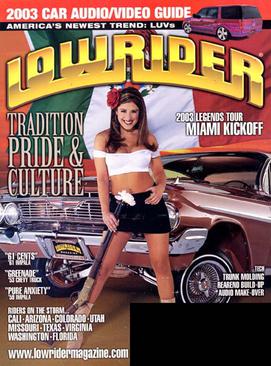Related Research Articles

Homies are a series of two-inch plastic collectible figurines representing various Chicano Mexican American characters. The line of toys was created by David Gonzales and based on a comic strip that Gonzales created featuring a cast of characters from his youth. Introduced in the year 1998, Homies were initially sold in grocery store vending machines and have become a highly collectible item, and have spawned many imitation toys.
The Palermos are a series of two-inch plastic collectible figurines created by David Gonzales. Representing an Italian American family and their associates, the Palermos debuted in 2004 as a spin-off of Gonzales' Homies figures.
Caló is an argot or slang of Mexican Spanish that originated during the first half of the 20th century in the Southwestern United States. It is the product of zoot-suit pachuco culture that developed in the 1930s and '40s in cities along the US/Mexico border.

The Super Powers Collection was a line of action figures based on DC Comics superheroes and supervillains that was created by Kenner Products in the 1980s.
Batman action figures have been produced since the 1940s.
Schleich is a German producer of handpainted toy figurines and accessories. The company is headquartered in Germany. The traditional market for Schleich products is Mainland Europe, with half their sales in Germany. The toys are sold worldwide and are quite popular in the United Kingdom, France, Australia and North America

Lowrider was an American automobile magazine, focusing almost exclusively on the style known as a lowrider. It first appeared in 1977, produced out of San Jose, California, by a trio of San Jose State students. In 2007, it was published out of Anaheim, California, and part of the Motor Trend Group. The magazine was closed in December 2019.
Art toys, also called designer toys, are toys and collectibles created by artists and designers that are either self-produced or made by small, independent toy companies, typically in very limited editions. Artists use a variety of materials, such as ABS plastic, vinyl, wood, metal, latex, plush, and resin. Creators often have backgrounds in graphic design, illustration, or fine art, but many accomplished toy artists are self-taught. The first art toys appeared in the 1990s in Hong Kong and Japan. By the early 2000s, the majority of art toys were based upon characters created by popular Lowbrow artists, linking the two movements.
Mijos are a series of plastic collectible figurines created by David Gonzales. Representing various Chicano Mexican American youth characters, Mijos debuted in 2004 as a spin-off of Gonzales' Homies figures. The Mijos line are specifically targeted at Hispanics — in this case, Hispanic children.
Stanley George Miller, better known as Mouse or Stanley Mouse, is an American artist who is notable for his 1960s psychedelic rock concert poster designs and album covers for the Grateful Dead, Journey, and other bands.
Disney Consumer Products, Inc. is the retailing and licensing subsidiary of the Disney Parks, Experiences and Products segment of The Walt Disney Company. Previously, Consumer Products was a segment of Disney until 2016, then a unit of Disney Consumer Products and Interactive Media (2016–2018).

Funko Inc. is an American company that manufactures licensed and limited pop culture collectibles, best known for its licensed vinyl figurines and bobbleheads. In addition, the company produces licensed plush, action figures, apparel, accessories and games.

The New Adventures of Zorro is an American animated television series produced by Filmation in 1981. The series, which has 13 episodes, is based on the fictional character created by Johnston McCulley. It aired as part of The Tarzan/Lone Ranger/Zorro Adventure Hour.

Vinylmation is a brand of 1.5", 3", and 9" vinyl collectible toys sold at Disney theme parks, select Disney Stores, and the online Disney Store. The name Vinylmation is a combination of the word Animation and Vinyl. Most figures are all shaped with the body of Mickey Mouse but have different themed markings, colors, and patterns. This means that all figures have round mouse ears, whether or not the painted character has them. This is accommodated by painting the ears with backgrounds - stars, stripes, rainbows - to match the painted character. The series exception is the Park Starz series which does not resemble Mickey at all, and more closely resembles iconic figures from the parks. Vinylmation was first introduced in July 2008, and the first figures were introduced in November 2008.
G.I. Joe is an American media franchise and a line of action figures owned and produced by the toy company Hasbro. The initial product offering represented four of the branches of the U.S. armed forces with the Action Soldier, Action Sailor, Action Pilot, Action Marine and later on, the Action Nurse. The name is derived from the usage of "G.I. Joe" for the generic U.S. soldier, itself derived from the more general term "G.I.". The development of G.I. Joe led to the coining of the term "action figure". G.I. Joe's appeal to children has made it an American icon among toys.

Disney Infinity is an action-adventure sandbox toys-to-life video game series developed by Avalanche Software. The setting of the series is a giant customizable universe of imagination, known as the Toy Box, populated with toy versions of iconic Disney, Pixar, Marvel and Star Wars characters.
Toys-to-life is a video game feature using physical figurines or action figures to interact within the game. These toys use a near field communication (NFC), radio frequency identification (RFID), or image recognition data protocol to determine the individual figurine's proximity, and save a player's progress data to a storage medium located within that piece. It was one of the most lucrative branches of the video game industry, with the Skylanders franchise alone selling more than $3 billion worth over the course of four years.

Tulipop is an Icelandic lifestyle brand founded in 2010. The company's original product line was a series of plush figures that resembled elements of nature, such as mushrooms and trees. The company went on to develop these characters, called Tulipoppers, in a variety of media, including a children's cartoon series that was released on YouTube in 2017. In 2017, Tulipop partnered with Hot Topic to release its first merchandise in the United States.

A cholo or chola is a member of a Chicano and Latino subculture or lifestyle associated with a particular set of dress, behavior, and worldview which originated in Los Angeles. A veterano or veterana is an older member of the same subculture. Other terms referring to male members of the subculture may include vato and vato loco. Cholo was first reclaimed by Chicano youth in the 1960s and emerged as a popular identification in the late 1970s. The subculture has historical roots in the Pachuco subculture, but today is largely equated with anti-social behavior, criminal behavior and gang activity.

Homie Rollerz is a 2008 kart racing game developed by Webfoot Technologies and published by Destineer for the Nintendo DS. The game is based on the plastic figurine line Homies by American cartoonist David Gonzales, and follows ten different characters from the figurine line racing each other in a competition set up by an elderly man named Vato Wizard, who has the ability to grant wishes.
References
- ↑ Macias, Chris. "Barrio Boon: Mijos Figures Are All The (Commercial) Rage," Sacramento Bee (Aug. 3, 2004).
- 1 2 3 4 5 6 Mendoza, Beto. "David Gonzales Art - Creator of the Homies: Lowrider Draw the Line," Archived 2015-01-03 at the Wayback Machine Lowrider (June 18, 2013).
- 1 2 3 4 5 6 Becerra, Hector (18 Dec 2007). "'Homies' are Where His Art Is". LA Times. Retrieved 28 March 2012.
- 1 2 3 4 5 Bir, Sara. "Where the Heart Is: With Homies, gangsta is in the eye of the beholder," Metroactive (Apr. 10, 2003).
- ↑ Fischer, Zane. "Homie Sweet Homie: Sexy urban icons have New Mexico roots," Santa Fe Reporter (February 4, 2009).
- 1 2 Napolitano, Jo. "Two-Inch Latino Role Models, for Good or Ill," New York Times (May 1, 2003).
- 1 2 3 Alonso, Alex (May 12, 2000). "Homies Figures: The Original Homies". StreetGangs.com. Retrieved 28 March 2012.
- ↑ Wortham, Stanton (1 January 2011). "Homies in the New Latino Diaspora". ScholarlyCommon. 31 (3): 191–202. doi:10.1016/j.langcom.2011.02.007.
- ↑ Sullivan, James. "Homies go from figurines to branding phenomenon: Richmond native has runaway success," San Francisco Chronicle (June 10, 2003).